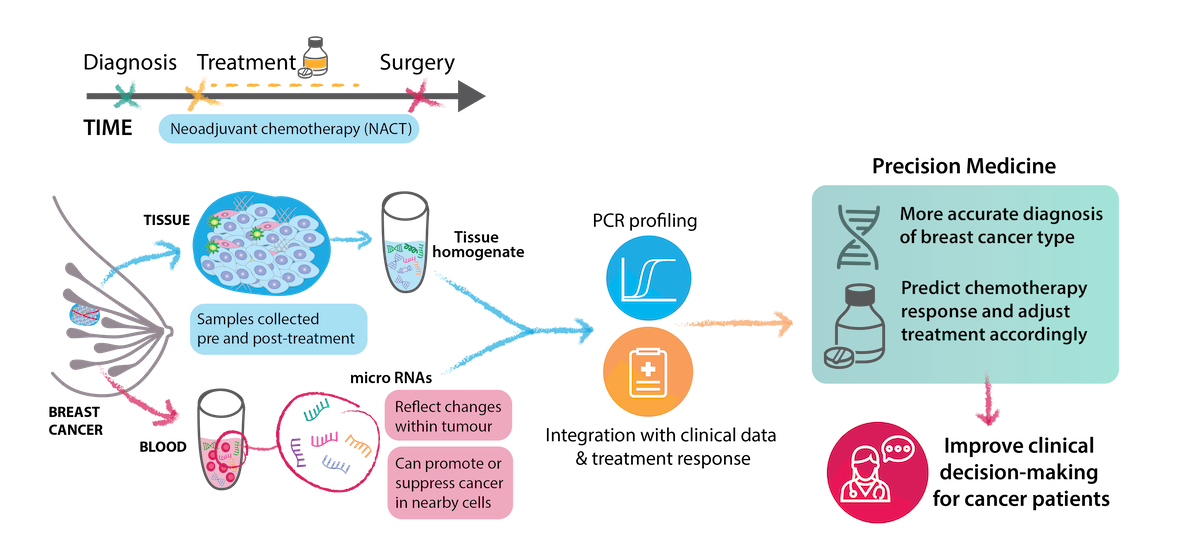

P1.4: microRNAs for the detection of breast cancer
Plain Language Summary
An estimated 7.8 million women alive worldwide have been diagnosed with breast cancer over a period of 5 years making breast cancer the world’s most prevalent cancer and was also estimated to affect 31.5% of women in Ireland during 2018-2020. The disease is easily manageable if detected and treated early. Current methods of breast tumor detection rely on scanning and mammography that fail in detection at the initial stages of the tumor when the tumor size is less than 1mm (size of a rice grain or tip of a pencil).
Most cells secrete small fragments of the cellular content into the blood that include proteins, lipids (fats/cholesterol), fragments of genetic information called DNA (deoxyribonucleic acid), and smaller derivatives of DNA that are single strands of 25-40 nucleotide units termed as microRNAs (micro ribonucleic acid). Most secreted genetic material can bind to neighboring normal cells and change them to cancer-supporting cells. Any changes in genetic content are first reflected in microRNAs which are always present within the cellular system. These microRNAs remain stable in blood and are capable of providing accurate information on the disease status of an individual.
Our research group at NUIG has identified several microRNAs (miRNAs/miRs) found freely circulating in the blood through a molecular technique called real-time PCR analysis that is highly specific and accurate in quantifying the expression levels of miRs. The presence or absence of specific miRs in blood has the potential to screen the presence of breast cancer, group patients to different breast cancer subtypes. and also enable prediction of patient’s response to chemotherapy.
With this knowledge, we would be able to prevent the administration of overdoses of chemo drugs and avoid the side effects it causes in patients who do not benefit from the drug (non-responder). Blood-based screening for microRNAs in breast cancer is an emerging concept in personalized precision medicine with several pros. The first being a non-invasive technique with ease of sampling through venous blood and equally informative in an out-patient clinical setting.
Visual Abstract
Project Overview
MicroRNAs (miRNAs) are short non-coding RNA sequences which play a key role in the post-transcriptional regulation of gene expression within cells, and are also actively secreted into the bloodstream. miRNAs are abnormally expressed in multiple cancer types, and the circulating miRNA profile can reflect dynamic adaptations of tumours during disease progression and treatment. Consequently, interest in exploiting miRNAs as biomarkers has exploded in recent years. This project is focused on circulating miRNAs in breast cancer, which Prof. Kerin’s group have previously shown are dysregulated, and can predict patient survival and response to therapy.
Neoadjuvant chemotherapy (NACT) is used in locally advanced breast cancer to reduce tumour burden prior to surgery, increasing the number of patients suitable for breast conserving surgery. It also provides a unique opportunity for assessment of tumour response to chemotherapy. Pathological complete response (pCR), where the tumour is completely eradicated following NACT, is associated with improved survival. However, only ~18% of patients will achieve a pCR, and there is no reliable clinically validated biomarker that can predict which patients will respond. With such a low benefit to toxicity ratio, the ability to predict patient response rates would be immensely beneficial. Prof. Kerin recently led a blinded, multi-centre, prospective clinical trial (ICORG 10-11) monitoring the impact of NACT on miRNA signatures in the blood of breast cancer patients. This initial analysis identified a panel of miRNAs predictive of response to NACT, potentially providing a way to more accurately select patients that will benefit from chemotherapy. Here, we are conducting prospective trials to validate the initial finding. This study includes the analysis of repeat tissue biopsies to determine the link with circulating profiles, and sequencing and array analysis to identify novel miRNAs with predictive potential.
This project breaks new ground as it combines advanced methodologies with a clinical study to deliver frontline results revealing the true value of miRNAs as diagnostic and predictive tools. It has the potential to transform the detection and classification of breast cancer and is perfectly poised for rapid translation to the clinical setting.
For further information, visit:
(opens in a new window)https://www.universityofgalway.ie/surgery/
(opens in a new window)https://www.breastcancerresearch.ie/
Key References:
- Heneghan HM, Miller N, Kelly R, Newell J, Kerin MJ. Systemic miRNA-195 differentiates breast cancer from other malignancies and is a potential biomarker for detecting noninvasive and early stage disease.Oncologist. 2010;15(7):673-82. PMID: 20576643
- Waters PS, Dwyer RM, Brougham C, Glynn CL, Wall D, Hyland P, Duignan M, McLoughlin M, Newell J and Kerin MJ. Impact of Tumour Epithelial Subtype on Circulating microRNAs in Breast Cancer Patients.PLoS One(2014) Mar 13;9(3):e90605. PMID: 24626163
- McDermott AM, Miller N, Wall D, Martyn LM, Ball G, Sweeney KJ, Kerin MJ. Identification and validation of oncologic miRNA biomarkers for luminal A-like breast cancer.PLoS One. 2014 Jan 31;9(1):e87032. PMID: 24498016
- O’Brien KP, Ramphul E, Howard L, Gallagher WM, Malone C, Kerin MJ and Dwyer RM. (2017) 'Circulating microRNAs in Cancer' for Book entitled 'Micro RNA Profiling: Methods and Protocols' Springer Science + Business Media, LLC, New York. Methods Mol Biol. 2017; 1509:123-139. PMID: 27826923
- McAnena P, Tanriverdi K, Curran C, Gilligan K, Freedman JE, Brown JAL, Kerin MJ. “Circulating microRNAs miR-331 and miR-195 differentiate local luminal a from metastatic breast cancer.BMC Cancer. 2019 May 10;19(1):436. PMID: 31077182
Project team




